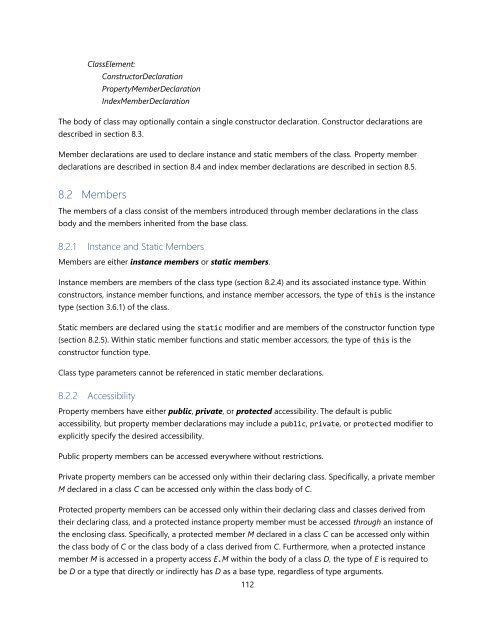TypeScript Language Specification v1.5
TypeScript Language Specification v1.5
TypeScript Language Specification v1.5
Create successful ePaper yourself
Turn your PDF publications into a flip-book with our unique Google optimized e-Paper software.
ClassElement:<br />
ConstructorDeclaration<br />
PropertyMemberDeclaration<br />
IndexMemberDeclaration<br />
The body of class may optionally contain a single constructor declaration. Constructor declarations are<br />
described in section 8.3.<br />
Member declarations are used to declare instance and static members of the class. Property member<br />
declarations are described in section 8.4 and index member declarations are described in section 8.5.<br />
8.2 Members<br />
The members of a class consist of the members introduced through member declarations in the class<br />
body and the members inherited from the base class.<br />
8.2.1 Instance and Static Members<br />
Members are either instance members or static members.<br />
Instance members are members of the class type (section 8.2.4) and its associated instance type. Within<br />
constructors, instance member functions, and instance member accessors, the type of this is the instance<br />
type (section 3.6.1) of the class.<br />
Static members are declared using the static modifier and are members of the constructor function type<br />
(section 8.2.5). Within static member functions and static member accessors, the type of this is the<br />
constructor function type.<br />
Class type parameters cannot be referenced in static member declarations.<br />
8.2.2 Accessibility<br />
Property members have either public, private, or protected accessibility. The default is public<br />
accessibility, but property member declarations may include a public, private, or protected modifier to<br />
explicitly specify the desired accessibility.<br />
Public property members can be accessed everywhere without restrictions.<br />
Private property members can be accessed only within their declaring class. Specifically, a private member<br />
M declared in a class C can be accessed only within the class body of C.<br />
Protected property members can be accessed only within their declaring class and classes derived from<br />
their declaring class, and a protected instance property member must be accessed through an instance of<br />
the enclosing class. Specifically, a protected member M declared in a class C can be accessed only within<br />
the class body of C or the class body of a class derived from C. Furthermore, when a protected instance<br />
member M is accessed in a property access E.M within the body of a class D, the type of E is required to<br />
be D or a type that directly or indirectly has D as a base type, regardless of type arguments.<br />
112


















